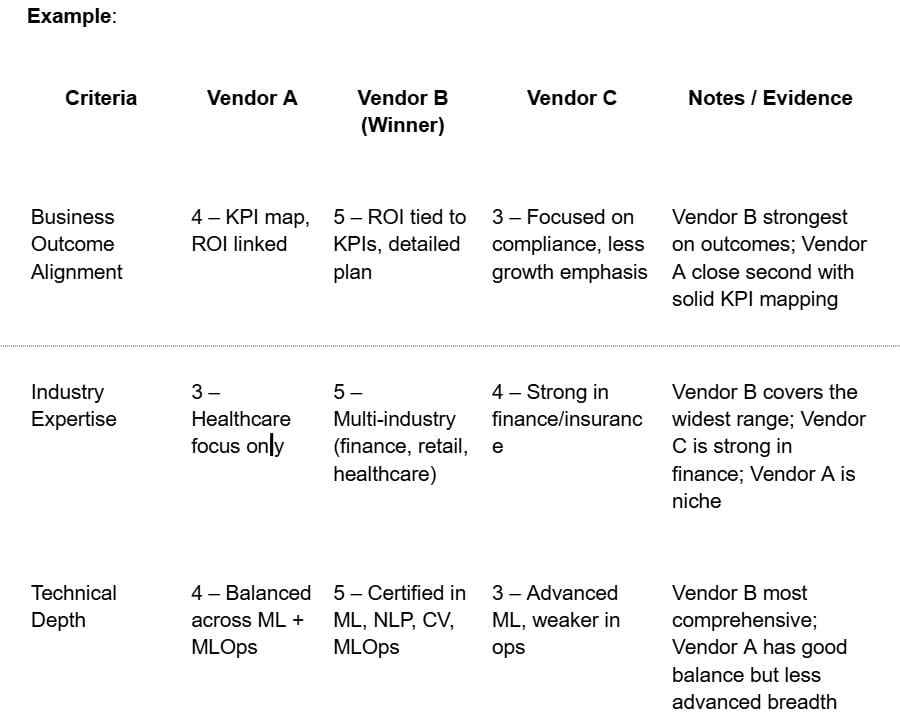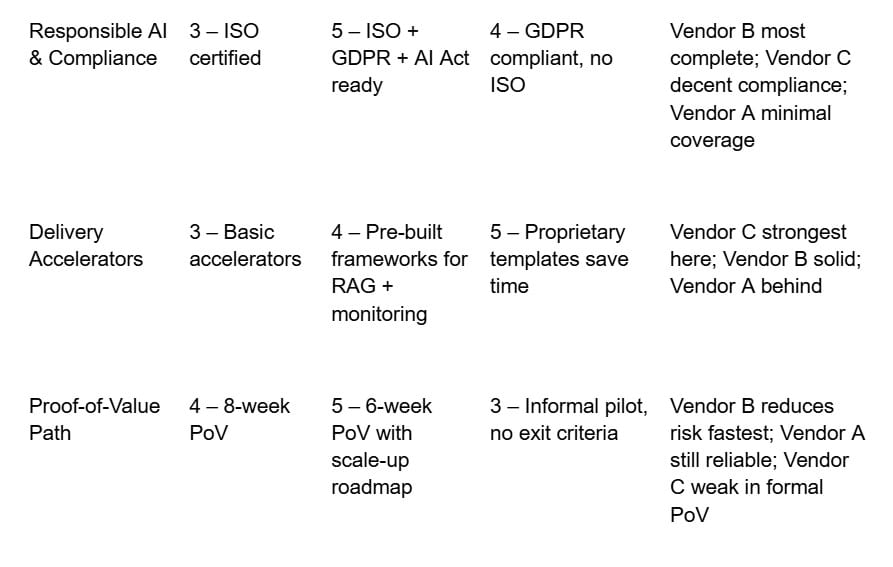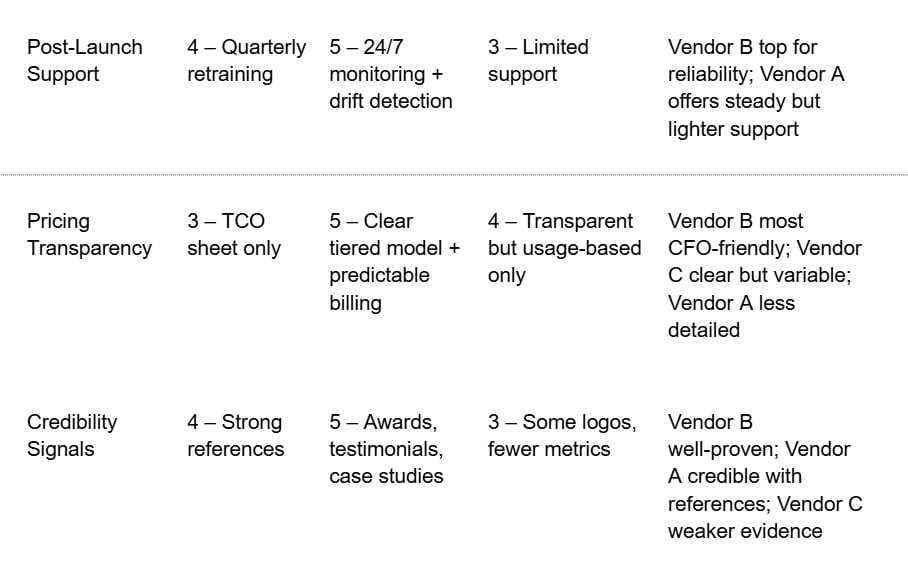When organizations evaluate an AI consulting service, the decision is rarely about technology demonstrations. What matters most is whether the partner can deliver measurable business outcomes, reduce operational risks, and provide clarity before major investments are made.
Executives expect every engagement to be tied to tangible results such as revenue growth, efficiency gains, or improved customer experience. They value proof-of-value pilots that validate outcomes quickly while limiting exposure and cost. Pricing transparency and a clearly defined approach are critical, leaders want predictable budgets and a process they can follow without ambiguity.
Trust is another non-negotiable factor. Firms must demonstrate compliance with security standards, ethical guidelines, and regulatory requirements. Beyond initial deployment, buyers also look for continuous support: monitoring, retraining, and drift management to ensure that solutions remain reliable over time.
Without these fundamentals, organizations risk joining the majority of AI projects that stall before delivering impact. The following sections outline how to assess potential partners against these expectations with confidence.
10 Key Criteria for Choosing the Right AI Consulting Partner
1. Aligning AI Consulting with Business Outcomes
The most reliable sign of a strong AI consulting partner is the ability to connect every project to business outcomes that matter at the executive level. A qualified firm will not start with algorithms or tools, it will start with measurable objectives such as revenue growth, operational efficiency, customer satisfaction, or regulatory compliance.
To validate this, ask how the partner defines success at the outset. Do they create KPI maps tied to your P&L? Can they show examples of previous engagements where AI initiatives directly supported business priorities? A credible firm should provide a structured approach that links technical execution with financial and operational results.
When this alignment is missing, organizations risk ending up with proofs of concept that impress in isolation but never scale or contribute to strategy. By prioritizing partners who demonstrate outcome-driven methods, you ensure that AI investments are evaluated the same way as any other enterprise initiative, by the value they deliver.
2. Domain Expertise and Industry Knowledge
AI solutions succeed when they are designed with a clear understanding of the industry context in which they operate. Every sector, whether healthcare, finance, manufacturing, or retail, has its own regulations, workflows, customer behaviors, and legacy systems. A consulting partner with proven domain knowledge can anticipate these nuances and design solutions that are practical, compliant, and adoption-ready.
When evaluating a partner, look for evidence of prior projects in your industry. Case studies, client references, or thought leadership content can reveal whether they have solved challenges similar to yours. A firm with relevant experience can shorten implementation timelines by reusing patterns, avoiding common pitfalls, and applying lessons learned from comparable organizations.
Choosing a consultant without industry grounding often results in generic solutions that fail to integrate smoothly or meet compliance standards. Prioritizing domain expertise ensures that your AI initiatives are not only technically sound but also aligned with the realities of your market and its regulatory environment.
3. Proven Track Record and Case Studies
Choosing an AI consulting partner is ultimately a decision about trust. Leaders want assurance that the firm has delivered results for organizations facing challenges similar to their own. A proven track record, backed by case studies, provides that confidence.
When evaluating a partner, look beyond generic claims of expertise. Ask for specific examples that match your industry, business model, or technology environment. For instance, if you lead a healthcare provider, a case study showing how the firm improved patient throughput with AI scheduling carries more weight than a generic chatbot project in retail.
Case studies also serve another purpose: they allow you to estimate the return on investment. By seeing how another company reduced costs, accelerated reporting, or increased revenue through AI, you can benchmark expectations for your own initiative. A reliable partner will make these outcomes transparent, with metrics, timelines, and lessons learned, because they know decision-makers like you don’t invest in promises, but in proof.
4. Collaborative Approach and Transparency
Choosing an AI consulting partner is not a handover, it is a partnership. The firms that deliver lasting impact are the ones that keep your team engaged at every stage, from initial planning to post-deployment support.
When you evaluate a partner, look for signs of how they communicate. Do they share progress openly, explain setbacks early, and provide clear milestones? A transparent approach prevents surprises and helps your leadership team stay aligned on timelines, costs, and outcomes.
Equally important is how collaborative they are with your people. The right firm will treat your staff as part of the project, not bystanders. This means offering knowledge transfer, involving business users in testing, and ensuring your teams gain confidence in managing AI systems long after go-live.
Ultimately, you should feel that the consultant is working with you, not just for you. When collaboration and transparency are built into the relationship, the result is not just an AI solution, it’s an empowered organization ready to scale it.
5. Customized and Flexible AI Consulting Services
Every organization’s AI journey is different. What you need from a consulting partner depends on your data maturity, budget boundaries, compliance requirements, and the specific outcomes your leadership team expects. A credible partner understands this and adapts their methods instead of forcing a one-size-fits-all framework.
In real terms, this means the firm should be willing to adjust engagement models, whether you need end-to-end delivery, targeted support for a critical project, or co-creation with your internal teams. Their solutions should be designed around your context: the type of data you manage, the systems you already use, and the pace at which your teams can adopt new tools.
A flexible partner also respects financial realities. You should be able to choose services that matter most without paying for unnecessary extras. This kind of customization ensures your organization gets the benefits of AI while staying aligned with business constraints, decision-making rhythms, and growth priorities.
6. Proof-of-Value Path
One of the most practical ways to de-risk AI adoption is to insist on a clear proof-of-value (PoV) stage before committing to full rollout. For most leaders, the concern is not whether a model works in theory, but whether it can deliver impact within the unique constraints of their business, budget, data quality, regulatory boundaries, and existing systems.
A capable consulting partner will design pilots that run against your real data, with defined exit criteria and timelines. They should make it easy for you to see what success looks like, whether it’s faster reporting, reduced manual effort, or higher customer engagement, and provide a transparent plan for scaling once results are confirmed.
Think of this stage as your safeguard. It gives your team tangible evidence before larger investments, while giving leadership the confidence that the project can move from a controlled test into enterprise-wide value. A partner that cannot articulate this path puts you at risk of stalled pilots and wasted spend.
7. Post-Launch Operations and Continuous Reliability
Selecting the right AI consulting partner is not only about deployment—it’s about what happens the day after your system goes live. Many organizations discover too late that a lack of post-launch support leads to performance drift, mounting errors, and declining trust from business users.
The right partner will design for long-term reliability from the start. That means committing to continuous monitoring of models, proactive drift detection, and regular retraining cycles so the solution keeps pace with changing data and business conditions. Just as important, they should provide clear runbooks for incident response and a governance framework that allows your internal team to understand, adjust, and take ownership when needed.
When evaluating firms, ask them to show how they manage AI systems six months or a year after launch. Request examples of monitoring dashboards, retraining schedules, or operational KPIs. A consulting partner that can demonstrate sustained performance is the one that will help your organization move beyond pilots and build lasting business value.
8. Pricing Transparency and Total Cost of Ownership
For most executives, the question is not simply “How much will this cost?” but “Will this investment remain predictable and defensible over time?” A trusted AI consulting partner recognizes this and approaches pricing with clarity from the very beginning.
You should expect more than a rate card. A reliable firm will break down what is fixed versus variable, what costs are one-time versus recurring, and how cloud usage or model retraining might affect your long-term spend. The best partners go further by offering a total cost of ownership (TCO) view, factoring in data preparation, integration, infrastructure, licensing, and ongoing support.
When pricing is vague or hidden behind technical complexity, it increases risk and undermines trust. A partner that openly shares pricing models, provides sensitivity analysis, and aligns costs to your financial planning process makes the decision far easier. Transparency here isn’t just about numbers; it’s about creating confidence that your AI strategy can scale without unpleasant surprises.
9. Credibility and Trust Signals
When you’re about to commit significant resources to an AI consulting partner, the final filter is trust. Beyond technical skills and frameworks, you need confidence in who will actually deliver the work and how they’ve done it before.
A credible partner introduces you to the people who will be on your project, not just a sales team. You should see clear profiles of their consultants, certifications that prove current expertise, and examples of similar projects with measurable results. Case studies, reference calls, or even a walk-through of lessons learned from past engagements all reduce uncertainty.
Think of this as your due diligence. Just as you would never sign a major contract without reviewing financials, you should not move forward without verifying a firm’s ability to deliver through transparent evidence. The strongest partners make this process easy, they showcase their team, their methods, and their outcomes upfront, so you don’t have to guess what working with them will feel like.
10. Future Readiness and Adaptability
Even the strongest AI solutions can lose relevance if they are not designed with change in mind. A reliable consulting partner will help you prepare for what’s next—whether that means integrating new models, aligning with evolving regulations, or adapting to shifts in your industry.
The test here is simple: ask how they keep solutions current once delivered. Do they have a roadmap for adopting emerging technologies like generative AI or multi-agent systems? Can they demonstrate how their methods adjust to new compliance standards such as ISO 42001 or the EU AI Act?
When adaptability is built in from the start, your AI investments stay valuable over the long term. Without it, you risk owning systems that deliver quick wins but fail to scale as the market and technology evolve.
AI Consulting Vendor Comparison Matrix
Once you know the criteria that matter, the next challenge is comparing firms in a way that goes beyond marketing claims. A practical way to do this is to use a shortlisting matrix that puts every potential partner against the same measures. This turns what is often a subjective decision into a structured, business-ready evaluation.
Start with a table that lists the nine success criteria down the left column, business outcome alignment, industry expertise, technical depth, responsible AI, accelerators, proof-of-value path, post-launch support, pricing transparency, and credibility signals. Across the top, add the vendors you are considering. For each cell, note what evidence they provided: KPI mapping documents, case studies, compliance certifications, or sample operating models.



How to Use It
- Score each vendor (e.g., 1–5) or mark.
- Add evidence links in the last column (case study, reference doc, compliance cert).
This simple framework does two things. First, it allows you to compare vendors on equal terms, without being swayed by the strength of a presentation or pitch. Second, it creates an internal record that can be shared with your leadership team, making the decision process transparent and defensible.
By the end of this exercise, the right partner usually becomes obvious—not because they made the loudest promise, but because their evidence consistently supports your priorities.
AI Consulting Costs and Pricing Models Explained
Budget conversations with AI consulting firms often create the most uncertainty. Leaders don’t just want a price tag, they want to know what drives cost, what can be controlled, and how to avoid unpleasant surprises once a project begins.
The first thing to clarify is the engagement model. Some firms work on advisory retainers, some on fixed-scope projects, and others on long-term managed AI operations. Each comes with trade-offs in flexibility, accountability, and cost predictability.
Next, understand the hidden variables. Data preparation, licensing for third-party tools, cloud consumption fees, and the cost of retraining models often sit outside the headline proposal. A partner that is transparent will provide a total cost of ownership (TCO) view, not just a project quote. Solutions like Sage IT’s mAITRYx™ help here by controlling many of these hidden cost drivers through built-in accelerators for data handling, monitoring, and governance, making pricing more predictable.
The most reliable firms also offer a proof-of-value phase: a smaller, time-boxed project that validates ROI before you commit to larger spend. This lowers risk and builds confidence across leadership teams.
By approaching pricing this way, you can judge partners not only on what they charge, but on whether they help you protect your budget while still achieving measurable outcomes.
Implementation Roadmap Template (90-Day Plan)
Selecting the right partner is only the beginning, what matters next is how quickly you can move from agreement to measurable impact. A clear 90-day roadmap helps leaders align teams, manage expectations, and reduce the risk of projects drifting.
Weeks 0–2: Align and Assess
Define business KPIs, validate data readiness, and agree on success criteria. At this stage, you should see a documented link between objectives and outcomes, so leadership feels confident about the investment.
Weeks 3–6: Prototype with Guardrails
Run a focused proof-of-value pilot designed to show measurable results without overcommitting resources. The goal here is learning and validation, not perfection.
Weeks 7–10: Harden and Prepare for Scale
Refine the solution, address security and governance requirements, and establish monitoring processes. This ensures the system is stable, compliant, and ready for wider deployment.
Weeks 11–12: Launch and Review
Move the solution into production under agreed service levels. Conduct a leadership review that compares results against KPIs, and decide on scaling.
This roadmap gives executives a predictable timeline and clear checkpoints. It also makes the process transparent for stakeholders, ensuring confidence that the project is moving from strategy to delivery without wasted effort.
Choosing an AI Consulting Company with Confidence
If you’re asking how to choose the right AI consulting company, the answer is simple: focus on proof, not promises. Look for a partner that ties every project to business outcomes, shares transparent pricing, proves value through pilots, and commits to ongoing support. These are the signals that separate firms that talk about AI from those that deliver it.
By using the criteria in this guide, you’ll move from uncertainty to clarity. You’ll be able to choose a consulting company that reduces risk for your business, gives your team confidence in the journey ahead, and ensures AI becomes a source of measurable growth, not stalled experiments.



